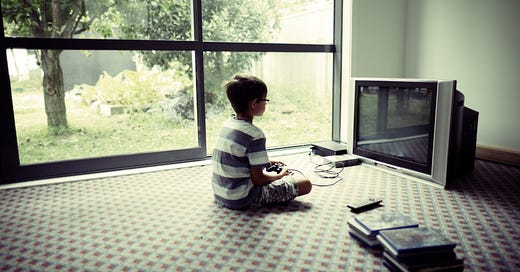Editor’s Note: Originally published at The Roots of Liberty May 2018. While I wait for additional details on the Texas shooting - details that can improve our understanding and inform our responses (e.g. current reports indicate that the shooter was “active” in the school for a good 40 minutes, after “storming past” an armed guard before being taken down - by a CBP agent who went against protocol), I am revisiting blog posts written in the wake of previous shootings. Today’s addresses what I feel is the emerging root of our problem - the alienation and isolation of young men in today’s America.
Friday brought us the horror of yet another school shooting incident, one that, unlike an attempt a few days earlier that was thwarted by an armed resource officer, claimed ten lives. The usual voices of outrage and anger mouthed their usual statements and demands for action, and many did so before we even knew the who, what, how, or why. Those who do so don’t deserve to receive much heed, because their disinterest in the particulars of a situation speaks of their unseriousness in addressing actual causes or prescribing viable remedies.
Let me get the gun arguments out of the way first. None of the various proposals for stricter gun measures: “assault weapon” bans (or, more broadly, semi-automatic firearm bans), tighter background checks, raising the gun purchase age to 21, bump stock bans, or purchase waiting periods, would have stopped this 17 year old shooter. He used a shotgun and a revolver in his killing, and he took (stole?) the guns from his father, who legally owned them. He apparently planned this atrocity for quite some time, as well, and there are early reports of explosive devices planted around the school.
Furthermore, there were no clear “red flags” or past incidents with law enforcement or the mental health system, that might have led someone paying attention to his door.
This leaves us with the wholly discomforting conclusion that this was an incident that, even in retrospect, offers no suggestion for preventative measures.
What can we do, then?
One thing that’s rarely or never mentioned in these incidents is the possibility that this behavior, exhibited too often by teenage or post-teen boys and men, is itself a result of a societal shift in how boys are raised and educated.
Yesterday, I read a sad lament, by Mike Rowe, about the demise of the Boy Scouts that he knew and belonged to as a boy. As I did, I flashed back to an interview I read with Maurice Sendak about the film adaptation of his children’s classic Where The Wild Things Are. Sendak noted (as I recall), in that interview, that there “needed to be danger” in the story. Similarly, he dismissed parents and others who worried that the tale is “too frightening” for little children. Between Rowe, Sendak, and my own observations of our culture’s current treatment of boys, I see the possible roots of the societal sickness and dysfunction that produced killers like the one in Texas this week.
Those of us of a certain age are likely-to-certain to remember a youth of roughhousing, physicality, rambunctiousness, competitiveness, friends, not-friends, enemies, bullies, victims, athletes, nerds, and the like. Bikes were ridden everywhere, hours were spent out of the house, with no structure or adult supervision, mistakes were made, knees and elbows were skinned. Boys were boys, and more importantly, were allowed to be boys. Not Your Average Dictionary defines a boy as a “noise with dirt on it.”
Our culture, of late, has turned a frown towards boyish behavior. This isn’t a revelation. Author Christina Hoff Sommers discusses, in her book The War Against Boys, how boys’ education and well-being has been subordinated to that of girls, as part of a misguided and corrosive effort to make up for a supposedly male-dominated society. Boys are taught to act in ways that run contrary to their natural proclivities. Those who act too much like boys are deemed to have behavioral problems, and remedies up to and including medication have become commonplace.
Stacked on top of this are helicopter parenting, zero-tolerance school policies, our safety paranoia that has us bubble-wrapping kids, structured play-dates, elimination of games like tag, dodgeball, and any other traditional kids’ game that might have any element of physical risk or bruised ego, and countless other “new parenting” philosophies. Boys of 30 and 40 years ago didn’t live in a panacea, but I defy anyone to tell me that they, collectively, grew up to be as flimsy as today’s appear to be.
I cannot help but wonder how much this de-manning of our boys has contributed to the mental affliction that has prompted school shooters to act as they have in recent years. I am in no way, shape, or form a mental health professional, but when we push people to act against their millennia-evolved natural proclivities, it seems logical that the resultant dissonances can lead to real problems. Is there a solution at hand? If we’re willing to undo the anti-boy trends of the past couple decades, perhaps we might see therein a remedy for that which has driven some to commit murder.





Again, you are Spot On. I shot .22 bolt-action match rifles on school property, during school hours, in JROTC, with very little supervision, in the late 1970’s - early 80’s. (We even won a National match.) We were “lightly” supervised while shooting - classrooms were adjacent to the range. In 2022, people would stroke out if they could go back in time and see that.
And “Where The Wild Things Are” is one of my favorite books. I read it to my three-year-old grandson last week.
Excellent, as always. I definitely think you're on to something there. Also, Politico ran this excellent article yesterday:
https://www.yahoo.com/news/really-consistent-pathway-society-stop-185445896.html
Maybe between what you've addressed here, and these professors, we can finally address the mass shooting epidemic. Though, I don't hold high hopes, I must admit